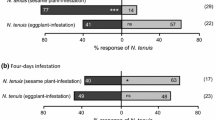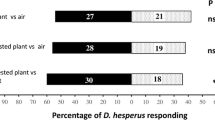Abstract
Using traps baited with natural and synthetic onion volatiles, we examined the effects of different habitats and mating on the olfactory behavior of laboratory-reared and wild onion flies. Rankings of olfactory treatments as host-finding stimuli for females were dependent on their mating status and the habitat in which they were foraging. In habitats devoid of hosts, traps baited with individual alkyl sulfides were as effective as 4-day-old chopped onions and more effective than 1-day-old onions in eliciting host-finding behavior in laboratory-reared unmated females (LUF) and laboratory-reared mated females (LMF). However, upwind dispersal and percent recapture were always significantly greater in LUF. In one experiment, Pr2S2 was 19 times more attractive to LMF in a fallow field, as than it was in an onion field. Reduced effectiveness of alkyl sulfides as host-finding stimuli in onion fields probably results in part because they are less findable, but more importantly because of a change in searching behavior after females have mated. Evidence to support the latter contention is that traps baited with alkyl sulfides and onions were equally findable by unmated females in both habitats. The behavior of LMF was identical to that of wild females, whereas the behavior of LUF was identical to wild males. The hypothesis that olfactory host-finding behavior in onion flies is modified by the resource level was upheld. Alkyl sulfides appear to be the primary, and possibly the only, chemical effectors of host-finding at the patch level of resource distribution, whereas the complex blend emitted by aged, chopped, or damaged onions appears to be acting at the final level of host-finding, while egg-laying females are moving between adjacent hosts in search of an optimal oviposition site.
Similar content being viewed by others
References
Batschelet, E. 1981. Circular Statistics in Biology. Academic Press, New York.
Bell, W.J. 1990. Searching behavior patterns in insects.Annu. Rev. Entomol. 35:447–468.
Bernhard, R.A. 1970. Chemotaxonomy: Distribution studies of sulfur compounds inAllium.Phytochemistry 9:2019–2027.
Cochran, W.G., andCox, G.M. 1957. Experimental Designs, 2nd ed. John Wiley & Sons, NewYork.
Dindonis, L.L., andMiller, J.R. 1980a. Host-finding responses of onion and seedcorn flies to healthy and decomposing onions and several synthetic constituents of onion.Environ. Entomol. 9:467–472.
Dindonis, L.L., andMiller, J.R. 1981a. Onion fly trap catch as affected by release rates ofn-dipropyl disulfide from polyethylene enclosures.J. Chem. Ecol. 7:411–418.
Dindonis, L.L., andMiller, J.R. 1981b. Onion fly and little house fly host-finding selectively mediated by decomposing onion and microbial volatiles.J. Chem. Ecol. 7:419–426.
Fein, B.L., Reissig, W.H., andRoelofs, W.L. 1982. Identification of apple volatiles attractive to the apple maggotRhagoletis pomonella.J. Chem. Ecol. 8:1473–1487.
Finch, S. 1980. Chemical attraction of plant-feeding insects to plants, pp. 67–143,in T.H. Coaker (ed.). Applied Biology, Vol. 5. Academic Press, New York.
Geurin, P.M., Stadler, E., andBuser, H.R. 1983. Identification of host plant attractants for the carrot fly,Psila rosae.J. Chem. Ecol. 9:843–861.
Gorlenko, M.V., Voronkevich, I.V., andMaximova, T.S. 1956. The interrelation ofHylemyia antiqua Meig. andEumerus strigatus Fall, with bacteria causing damp rot in plants.Zool. Zh. 35:16–20 (in Russian; English summary, supplement, p. 4).
Harris, M.O., andMiller, J.R. 1988. Host-acceptance behaviour in an herbivorous fly,Delia antiqua.J. Insect Physiol. 34:179–190.
Hassel, M.P., andSouthwood, T.R.E. 1978. Foraging strategies of insects.Annu. Rev. Ecol. Syst. 9:75–98.
`Hausmann, S.M., andMiller, J.R. 1989. Production of onion fly attractants and ovipositional stimulants by bacterial isolates cultured on onion.J. Chem. Ecol. 15:905–916.
Ikeshoji, T., Ishikawa, Y. andMatsumoto, Y. 1980. Attractants against the onion maggots and fliesHylemya antiqua, in onions inoculated with bacteria.J. Pestic. Sci. 5:343–350.
Ishikawa, Y., Ikeshoji, T., andMatsumoto, Y. 1981. Field trapping of onion and seed-corn flies with baits of fresh onion pulp.Appl. Entomol. Zool. 16:490–493.
Ishikawa, Y., Ikeshoji, T., andMatsumoto, Y. 1983. 2-Phenyl-ethanol: An attractant for the onion and seed-corn fliesHylemya antiqua andH. platura (Diptera: Anthomyiidae).Appl. Entomol. Zool. 18:270–277.
Jaenike, J. 1978. On optimal oviposition behavior in phytophagous insects.Theor. Pop. Biol. 14:350–356.
Judd, G.J.R. 1986. Integration of visual and olfactory host-finding mechanisms in the onion maggot,Delia antiqua (Meigen) (Diptera: Anthomyiidae). PhD thesis. Simon Fraser University, Burnaby, British Columbia, Canada.
Judd, G.J.R., andBorden, J.H. 1988. Long-range host-finding behaviour of the onion flyDelia antiqua (Diptera: Anthomyiidae): Ecological and physiological constraints.J. Appl. Ecol. 25:829–845.
Judd, G.J.R., andBorden, J.H. 1989. Distant olfactory response of the onion fly,Delia antiqua, to host-plant odour in the field.Physiol. Entomol. 14:429–444.
Judd, G.J.R., andBorden, J.H. 1991. Sensory interaction during trap-finding by female flies: Implications for ovipositional host-plant finding.Entomol. Exp. Appl. 58:234–249.
Kennedy, J.S. 1978. The concepts of olfactory “arrestment” and “attraction.”Physiol. Entomol. 3:91–98.
Martinson, T.E., Nyrop, J.P., andEckenrode, C.J. 1989. Long-range host-finding behavior and colonization of onion fields byDelia antiqua (Diptera: Anthomyiidae).J. Econ. Entomol. 82:1111–1120.
May, M.L., andAhmad, S. 1983. Host location in the Colorado potato beetle: Searching mechanisms in relation to oligophagy, pp. 173–200,in S. Ahmad (ed.). Herbivorous Insects: Host-Seeking Behavior and Mechanisms. Academic Press, New York.
Miller, D.R., andBorden, J.H. 1990.β-Phellandrene: Kairomone for pine engraver,Ips pini (Say) (Coleoptera: Scolytidae).J. Chem. Ecol. 16:2519–2531.
Miller, J.R., andStrickler, K.L. 1984. Finding and accepting host plants, pp. 127–202,in W.J. Bell and R.T. Cardé (eds.). Chemical Ecology of Insects. Chapman and Hall, London.
Miller, J.R., Harris, M.O., andBreznak, J.A. 1984. Search for potent attractants of onion flies.J. Chem. Ecol. 10:1477–1488.
Perron, J.P., Jasmin, J.J., andLafrance, J. 1958. Varietal resistance of seeded onions to the onion maggot,Hylemya antiqua (Meigen) (Diptera: Anthomyiidae).Can. Entomol. 90:653–656.
Perron, J.P., Jasmin, J.J., andLafrance, J. 1960. Attractiveness of some onion varieties grown in muck soil to oviposition by the onion maggot (Hylemya antiqua (Meigen) (Diptera: Anthomyiidae).Can. Entomol. 92:765–767.
Pierce, H.D., Jr., Vernon, R.S., Borden, J.H., andOehlschlager, A.C. 1978. Host selection byHylemya antiqua (Meigen): Identification of three new attractants and oviposition stimulants.J. Chem. Ecol. 4:65–72.
Prokopy, R.J. 1986. Visual and olfactory stimulus interaction in resource finding by insects, pp. 80–89,in T.L. Payne, M.C. Birch, and C.E.J. Kennedy (eds.). Mechanisms in Insect Olfaction. Clarendon Press, Oxford.
Pyke, G.H., Pulliam, H.R., andCharnov, E.L. 1977. Optimal foraging: A selective review of theory and tests.Qt. Rev. Biol. 52:137–154.
Schneider, W.D., Miller, J.R., Breznak, J.A., andFobes, J.F. 1983. Onion maggot,Delia antiqua, survival and development on onions in the presence and absence of microorganisms.Entomol. Exp. Appl. 33:50–56.
Theunisson, J.A.B.M. 1976. Aspects of gametogenesis and radiation pathology in the onion flyHylemya antiqua (Meigen). I. Gametogenesis.Meded. Landbouwhogech. Wageningen 76:1–164.
Ticheler, J. 1971. Rearing of the onion fly,Hylemya antiqua (Meigen) with a view to release of sterilized insects, pp. 341–346,in Sterility Principle for Insect Control or Eradication. International Atomic Energy Agency, Vienna.
Vernon, R.S., Borden, J.H., Pierce, H.D., Jr., andOehlschlager, A.C. 1978. Host selection byHylemya antiqua: Identification of oviposition stimulants based on proposed active thioalkane moieties.Environ. Entomol. 7:728–731.
Vernon, R.S., Judd, G.J.R., Borden, J.H., Pierce, H.D., Jr., andOehlschlager, A.C. 1981. Attraction ofHylemya antiqua (Meigen) (Diptera: Anthomyiidae) in the field to host-produced oviposition stimulants and their non-host analogues.Can. J. Zool. 59:872–881.
Visser, J.M. 1986. Host odor perception in phytophagous insects.Annu. Rev. Entomol. 31:121–144.
Visser, J.M., andAvé, D.A. 1978. General green leaf volatiles in the orientation of the Colorado beetle,Leptinotarsa decemlineata.Entomol. Exp. Appl. 24:538–549.
Wilson, E.O. 1968. Chemical systems, pp. 75–102,in T.A. Sebok (ed.). Animal Communication: Techniques of Study and Results of Research. Indiana University Press, Bloomington.
Zar, J. 1984. Biostatistical Analysis, 2nd ed. Prentice-Hall, Englewood Cliffs, New Jersey.
Zurlini, G., andRobinson, A.S. 1978. Onion conditioning pertaining to larval preference and rate of development in=Hylemya) antiqua.Entomol. Exp. Appl. 23:279–286.
Author information
Authors and Affiliations
Rights and permissions
About this article
Cite this article
Judd, G.J.R., Borden, J.H. Influence of different habitats and mating on olfactory behavior of onion flies seeking ovipositional hosts. J Chem Ecol 18, 605–620 (1992). https://doi.org/10.1007/BF00987823
Received:
Accepted:
Issue Date:
DOI: https://doi.org/10.1007/BF00987823




